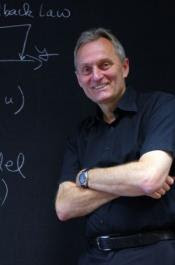Speaker
Description
Any (real or complex) square matrix $M$ can be split into $M=H+S$, where $H$ is the Hermitian and $S$ is the skew-Hermitian part of $M$. Interestingly, this splitting occurs naturally and with a physical meaning in applications that involve energy-based modeling using DAE systems in dissipative Hamiltonian form (dHDAEs). The applicability of this modeling approach has been demonstrated in a variety of application areas including thermodynamics, electromagnetics, and fluid mechanics. The linear algebraic systems that arise from the linearization and/or discretization of such dHDAEs have matrices of the form $M=H+S$, where $H$ is positive definite or positive semidefinite. This class of matrices has intriguing properties. We will discuss several important examples in this context as well as efficient approaches for solving the resulting linear algebraic systems iteratively. The talk will be based on joint work with Candan Güdücü, Volker Mehrmann, Justus Ramme (all TU Berlin), and Daniel Szyld (Temple University).

